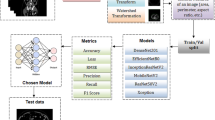Abstract
Kidney stone, cyst and tumour categorization are the more complex task for the radiologist to diagnosis the problem because these images are similar to one another for less experienced radiologist. An experienced radiologist may categorize the image more accurately. If the diagnosis of disease is precise, then the problem can be solved in the early stage or suppressed using medication. For this purpose, deep learning techniques can be used for automatic detection and categorization of the kidney-related problem. This paper will give a clear set of information about dataset selection and pre-processing, and the architecture used in various papers are discussed. Based on the understanding of VGG -16 and AlexNet, the proposed model was used for the classification of lesions in the kidney. The model gives an accuracy of 79%.





Similar content being viewed by others
Data availability
Dataset is taken from kaggle repository.
Change history
28 August 2023
A Correction to this paper has been published: https://doi.org/10.1007/s42979-023-02250-w
References
Yildirim K, Bozdag PG, Talo M, Yildirim O, Karabatak M, Acharya UR. Deep learning model for automated kidney stone detection using coronal CT images. Comput Biol Med. 2021 Aug;135:104569. https://doi.org/10.1016/j.compbiomed.2021.104569. Epub 2021 Jun 14. PMID: 34157470.
Fuzhe Ma, Tao Sun, Lingyun Liu, Hongyu Jing, Detection and diagnosis of chronic kidney disease using deep learning-based heterogeneous modified artificial neural network, Future Generation Computer Systems, Volume 111,2020, Pages 17–26, ISSN 0167–739X, https://doi.org/10.1016/j.future.2020.04.036.
Alnazer I, Bourdon P, Urruty T, Falou O, Khalil M, Shahin A, Fernandez-Maloigne C. Recent advances in medical image processing for the evaluation of chronic kidney disease. Med Image Anal. 2021 Apr;69:101960. https://doi.org/10.1016/j.media.2021.101960. Epub 2021 Jan 9. PMID: 33517241.
Lin Z, Cui Y, Liu J, Sun Z, Ma S, Zhang X, Wang X. Automated segmentation of kidney and renal mass and automated detection of renal mass in CT urography using 3D U-Net-based deep convolutional neural network. Eur Radiol. 2021;31(7):5021–31. https://doi.org/10.1007/s00330-020-07608-9. (Epub 2021 Jan 13 PMID: 33439313).
Han S, Hwang SI, Lee HJ. The classification of renal cancer in 3-phase CT images using a deep learning method. J Digit Imaging. 2019;32(4):638–43. https://doi.org/10.1007/s10278-019-00230-2.PMID:31098732;PMCID:PMC6646616.
Blau N, Klang E, Kiryati N, Amitai M, Portnoy O, Mayer A. Fully automatic detection of renal cysts in abdominal CT scans. Int J Comput Assist Radiol Surg. 2018;13(7):957–66. https://doi.org/10.1007/s11548-018-1726-6. (Epub 2018 Mar 15 PMID: 29546571).
N. Thein, H. A. Nugroho, T. B. Adji and K. Hamamoto, "An image preprocessing method for kidney stone segmentation in CT scan images," 2018 International Conference on Computer Engineering, Network and Intelligent Multimedia (CENIM), 2018, pp. 147–150. https://doi.org/10.1109/CENIM.2018.8710933.
Shah T, Kadge S. Analysis and identification of renal calculi in computed tomography images. Int Conf Nascent Technol Eng (ICNTE). 2019;2019:1–4. https://doi.org/10.1109/ICNTE44896.2019.8945877.
Verma J, Nath M, Tripathi P, et al. Analysis and identification of kidney stone using Kth nearest neighbour (KNN) and support vector machine (SVM) classification techniques. Pattern Recognit Image Anal. 2017;27:574–80. https://doi.org/10.1134/S1054661817030294.
Kline TL, Edwards ME, Fetzer J, Gregory AV, Anaam D, Metzger AJ, Erickson BJ. Automatic semantic segmentation of kidney cysts in MR images of patients affected by autosomal-dominant polycystic kidney disease. Abdom Radiol (NY). 2021 Mar;46(3):1053–1061. https://doi.org/10.1007/s00261-020-02748-4. Epub 2020 Sep 17. PMID: 32940759; PMCID: PMC7940295.
Islam MN, Hasan M, Hossain MK, et al. Vision transformer and explainable transfer learning models for auto detection of kidney cyst, stone and tumor from CT-radiography. Sci Rep. 2022;12:11440. https://doi.org/10.1038/s41598-022-15634-4.
Onthoni DD, Sheng TW, Sahoo PK, Wang LJ, Gupta P. Deep Learning Assisted Localization of Polycystic Kidney on Contrast-Enhanced CT Images. Diagnostics (Basel). 2020;10(12):1113. https://doi.org/10.3390/diagnostics10121113.PMID:33371503;PMCID:PMC7767504.
Dana J, Lefebvre TL, Savadjiev P, Bodard S, Gauvin S, Bhatnagar SR, Forghani R, Hélénon O, Reinhold C. Malignancy risk stratification of cystic renal lesions based on a contrast-enhanced CT-based machine learning model and a clinical decision algorithm. Eur Radiol. 2022;32(6):4116–27. https://doi.org/10.1007/s00330-021-08449-w. (Epub 2022 Jan 23 PMID: 35066631).
Noda Y, Kaga T, Kawai N, Miyoshi T, Kawada H, Hyodo F, Kambadakone A, Matsuo M. Low-dose whole-body CT using deep learning image reconstruction: image quality and lesion detection. Br J Radiol. 2021 May 1;94(1121):20201329. https://doi.org/10.1259/bjr.20201329. Epub 2021 Feb 22. PMID: 33571010; PMCID: PMC8506192.
Jackson P, Hardcastle N, Dawe N, Kron T, Hofman MS, Hicks RJ. Deep learning renal segmentation for fully automated radiation dose estimation in unsealed source therapy. Front Oncol. 2018;14(8):215. https://doi.org/10.3389/fonc.2018.00215.PMID:29963496;PMCID:PMC6010550.
Sudharson S, Kokil P. An ensemble of deep neural networks for kidney ultrasound image classification. Comput Methods Programs Biomed. 2020 Dec; 197:105709. https://doi.org/10.1016/j.cmpb.2020.105709. Epub 2020 Aug 23. PMID: 32889406.
Author information
Authors and Affiliations
Corresponding author
Ethics declarations
Conflict of interest
No conflict of interest.
Additional information
Publisher's Note
Springer Nature remains neutral with regard to jurisdictional claims in published maps and institutional affiliations.
This article is part of the topical collection “Machine Learning Modeling Techniques and Applications” guest edited by Lazaros Iliadis, Elias Pimenidis and Chrisina Jayne.
The original online version of this article was revised: In the original publication of the article, the second author name missed in the author group. Now, it has been updated.
Rights and permissions
Springer Nature or its licensor (e.g. a society or other partner) holds exclusive rights to this article under a publishing agreement with the author(s) or other rightsholder(s); author self-archiving of the accepted manuscript version of this article is solely governed by the terms of such publishing agreement and applicable law.
About this article
Cite this article
Sundaramoorthy, S., Jayachandru, K. Designing of Enhanced Deep Neural Network Model for Analysis and Identification of Kidney Stone, Cyst, and Tumour. SN COMPUT. SCI. 4, 466 (2023). https://doi.org/10.1007/s42979-023-01912-z
Received:
Accepted:
Published:
DOI: https://doi.org/10.1007/s42979-023-01912-z




